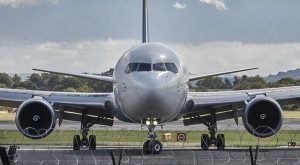 From small privately owned and operated propeller airplanes to large jet-powered commercial airplanes and military airplanes, all airplanes rely on thrust to travel in the air. It’s created by the engines (or engine), thereby allowing the airplane to move forward. Even if you’ve heard of thrust, though, you might be wondering what, exactly it is and how it works. In this post, we’re going to break down the force known as thrust.
From small privately owned and operated propeller airplanes to large jet-powered commercial airplanes and military airplanes, all airplanes rely on thrust to travel in the air. It’s created by the engines (or engine), thereby allowing the airplane to move forward. Even if you’ve heard of thrust, though, you might be wondering what, exactly it is and how it works. In this post, we’re going to break down the force known as thrust.
Overview of Thrust
Thrust is the invisible but powerful force that’s responsible for moving an airplane forward. All airplanes have one or more engines. As previously mentioned, some airplanes use propeller engines, whereas others use jet engines. Propeller engines feature a turbine blade that spins, whereas jet engines feature a combustion-powered propeller. Regardless, all engines create thrust that moves airplanes while they are in the air.
To better understand thrust, look no further than Newton’s Third Law. According to Newton’s Laws of Motion, for every action there’s an equal and opposite reaction. When an airplane’s engines are activated, they create an “action.” The response to this action is movement that propels the airplane forward.
What Is Reverse Thrust?
While all airplanes use thrust, some use reverse thrust as well. What is reverse thrust exactly? Also known as thrust reversal, it’s a feature that allows an airplane’s engines to divert thrust in the opposite direction.
Pilots don’t use reverse thrust when flying. They do, however, use it when landing. If a pilot is approaching the runway too fast, he or she may switch to reverse thrust. Once engaged, the airplane’s engines will change the direction of their thrust. So, instead of producing force that moves the airplane forward, the engines will produce thrust that pulls the airplane backward. The airplane won’t necessarily fly backwards. It will, however, slow down so that the pilot can land more safely.
In Conclusion
To recap, thrust is the force described by Isaac Newton that keeps airplanes moving. It’s important to note, however, that airplanes rely on other forces as well, such as lift. Thrust is responsible for moving airplanes forward, whereas lift is responsible for keeping them in the air. Thrust, as previously mentioned, is created by the airplane’s engines. In comparison, lift is created by the airplane’s wings. Thrust and lift work harmoniously together to allow airplanes to safely move through the air.



